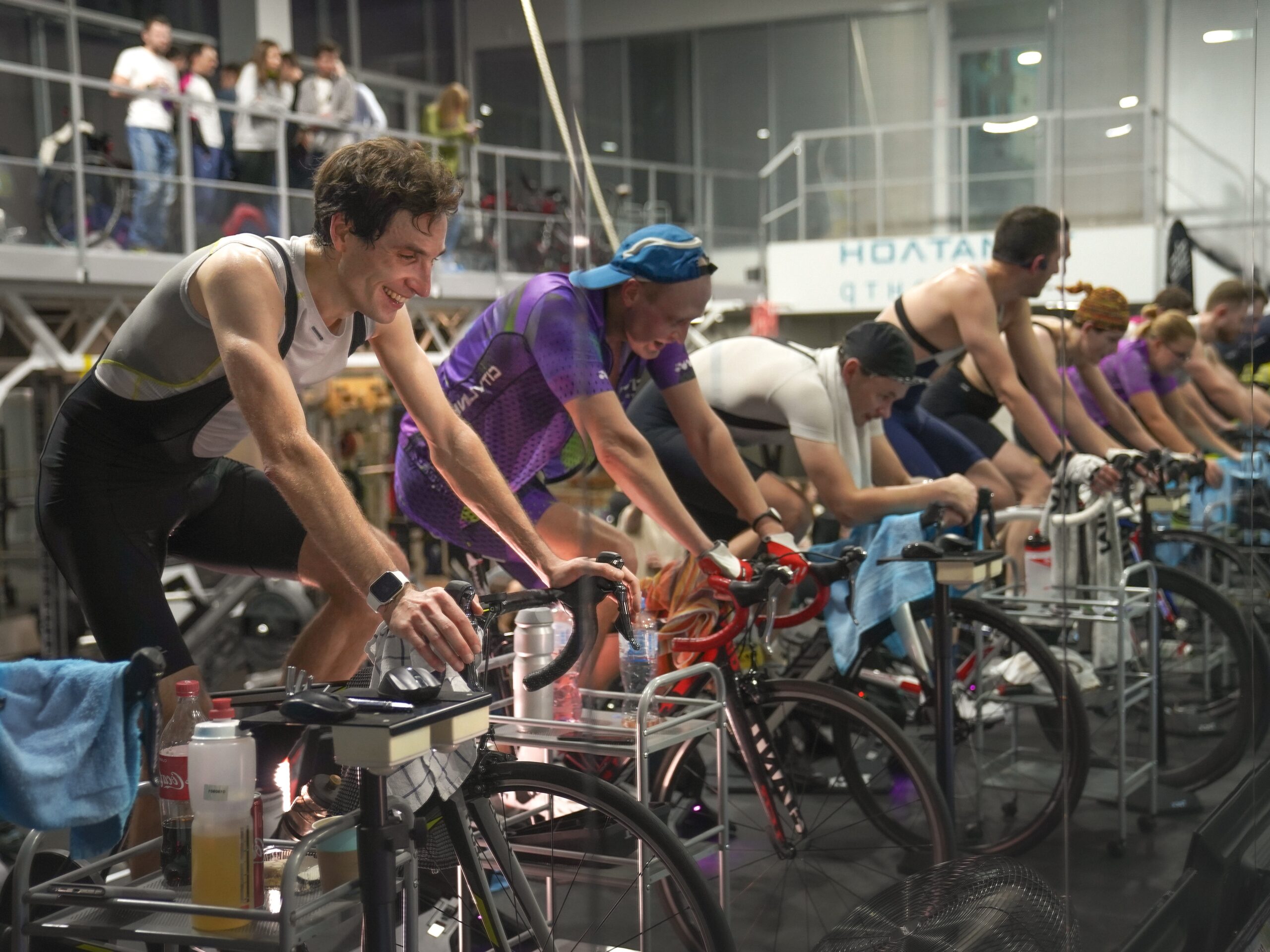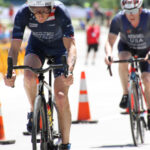One thing that every triathlete knows is that you can’t fake fitness or readiness. You simply can’t swim, bike, or run faster than you’ve trained yourself to go. Also, for most age-group triathletes, time is a precious commodity in limited supply, so it’s important that you get the most out of your training efforts.
bike, or run faster than you’ve trained yourself to go. Also, for most age-group triathletes, time is a precious commodity in limited supply, so it’s important that you get the most out of your training efforts.
You have three goals related to your training. First, to be maximally prepared physically and mentally for every workout. Second, to give your best effort in accomplishing your workout goals. Third, to gain the most benefit from those efforts. Achieving these goals are no small task because there is so much that can interfere with putting your best efforts toward a quality workout including time pressure, life stress, distractions, and pain.
#1: Routines
Most triathletes have some sort of race-day physical and mental routines they use to get themselves ready to race, but few have similar routines to prepare them to get the most out of their training efforts. Training routines ensure physical and mental readiness to maximize the value of your workouts. They also help  create consistency, so your body and mind become conditioned to know that, when you go through your training routine, you will be ready to give your best effort. They also ensure familiarity, predictability, and control, all of which are essential for bolstering motivation and confidence, reducing stress, and enhancing focus. A training routine might include pre-workout nutrition, physical warm-up, and a psychological and emotional transition from life mode to training mode (more on that shortly).
create consistency, so your body and mind become conditioned to know that, when you go through your training routine, you will be ready to give your best effort. They also ensure familiarity, predictability, and control, all of which are essential for bolstering motivation and confidence, reducing stress, and enhancing focus. A training routine might include pre-workout nutrition, physical warm-up, and a psychological and emotional transition from life mode to training mode (more on that shortly).
#2: Conscious Commitment
As every triathlete has experienced, you don’t always approach a workout in the best physical or mental state. You might be tired, stressed out, or distracted, in other words, your mind and/or body are just not fully there, resulting in your not being in the best place to have a quality workout. That’s why it’s so important to make a conscious commitment to give your best effort in a training session. When you say to yourself, “I’m committed to giving it my all in today’s workout,” you are taking control of your mind and body and commanding them to do what you want to do. It also creates a different default—best effort!—rather than “I’m not super psyched to be doing this now.”
important to make a conscious commitment to give your best effort in a training session. When you say to yourself, “I’m committed to giving it my all in today’s workout,” you are taking control of your mind and body and commanding them to do what you want to do. It also creates a different default—best effort!—rather than “I’m not super psyched to be doing this now.”
#3: Clear Goal
You can’t have a quality workout if you don’t know what your goal is or how to achieve it. Before each training session, review the goal for the day and what specifically you will be doing including duration,  structure (e.g., intervals, sets, reps, recovery), planned effort (e.g., RPE, wattage, pace), and performance targets. Research has shown that having a clear goal and how to accomplish it can improve motivation, focus, and the quality of workouts.
structure (e.g., intervals, sets, reps, recovery), planned effort (e.g., RPE, wattage, pace), and performance targets. Research has shown that having a clear goal and how to accomplish it can improve motivation, focus, and the quality of workouts.
#4: Take a Moment
Before you begin your workout, take a moment to transition from life to training. This hack involves closing your eyes, taking a few deep breaths, clearing your mind of whatever you brought to this point from your day, focusing on the task at hand, and connecting with your passion and goals. A tool I’ve been using with the pro triathletes I work with is to see themselves wearing a 30-lb. weight vest (symbolizing the burdens of life that we all carry around) and imagining themselves taking it off before the workout, experiencing the new feeling of lightness and energy that comes with removing the weight vest.
the burdens of life that we all carry around) and imagining themselves taking it off before the workout, experiencing the new feeling of lightness and energy that comes with removing the weight vest.
#5: Laser Focus
Our primitive brains and bodies don’t like triathlon training because it perceives the pain we experience no differently than the pain our ancestors felt on the Serengeti 250,000 years ago when we first officially became Homo Sapiens. Through evolution, we have learned that, when we experience pain, death is likely to follow, so our bodies have learned to ease up or stop when we feel pain. That reaction to pain may have worked very well for our forbearers, but it definitely doesn’t help us to achieve our triathlon goals in 2023. In other words, if our primitive brains and bodies had the choice, we would stop training as soon as it got the least bit uncomfortable.
have worked very well for our forbearers, but it definitely doesn’t help us to achieve our triathlon goals in 2023. In other words, if our primitive brains and bodies had the choice, we would stop training as soon as it got the least bit uncomfortable.
That is why it’s so important to maintain a laser focus from the start to the finish of workouts. As soon as you lose focus, your primitive side takes over and starts to throttle back your effort and you see a drop in your pace, power, and the quality of your training sessions. To help with keeping your laser focus, I encourage you to focus on your efforts, whether your perceived exertion, wattage output, pace, or whatever target metric you are following in your workout. I also discourage you from listening to podcasts, being on social media, or having conversations during your quality workouts (usually meaning high-intensity
whatever target metric you are following in your workout. I also discourage you from listening to podcasts, being on social media, or having conversations during your quality workouts (usually meaning high-intensity
efforts) because all are too distracting. Music is fine as long as it is used as a motivational tool rather than for distraction.
#6: Stick with the Plan
This suggestion can be interpreted in two ways. First, as we all know, triathletes can be a very motivated group and, as a result, may decide to deviate from their training plan for the day because they’re feeling really good. So, they decide to put their foot on the gas even more. The upside (sort of) is that you feel really strong, and these increased efforts can boost both your motivation and confidence. The downside (no sort of) is that your body can’t handle that level of intensity for long and you burn out quickly. One highly ranked PTO pro I work with did this all the time last year and, not surprisingly, he was so overtrained late in the season that his race results showed it. So, my admonition here is to stay disciplined and stick with the plan no matter how good you feel.
(no sort of) is that your body can’t handle that level of intensity for long and you burn out quickly. One highly ranked PTO pro I work with did this all the time last year and, not surprisingly, he was so overtrained late in the season that his race results showed it. So, my admonition here is to stay disciplined and stick with the plan no matter how good you feel.
Second, and conversely, there are going to be some days where you just aren’t feeling it and trying to stick with your workout plan when your body is telling you not to is another recipe for overtraining and burnout. In this case, you want to be agile with your training session and adapt your workout to what your body is saying. For example, you might decide to reduce the number of intervals or sets by half or ratchet back the intensity and go for easy volume instead. In doing so, you are listening to your body (an essential practice) and choosing to hit it hard another day when your body is willing and able.
If you can follow these six mind hacks consistently in your training, you will find that the quality of your preparations, efforts, and outcomes will increase, your fitness will steadily build, and, ultimately, your efforts will pay off by achieving your race goals.







